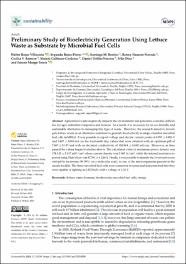Preliminary Study of Bioelectricity Generation Using Lettuce Waste as Substrate by Microbial Fuel Cells

View/
Download
(application/pdf: 1.760Mb)
(application/pdf: 1.760Mb)
Date
2023-06-30Author(s)
Rojas-Villacorta, Walter
Rojas-Flores, Segundo
Benites, Santiago M.
Nazario-Naveda, Renny
Romero, Cecilia V.
Gallozzo-Cardenas, Moisés
Delfín-Narciso, Daniel
Díaz, Félix
Murga-Torres, Emzon
Metadata
Show full item recordAbstract
Agricultural waste negatively impacts the environment and generates economic difficulties for agro-industrial companies and farmers. As a result, it is necessary for an eco-friendly and sustainable alternative to managing this type of waste. Therefore, the research aimed to investigate lettuce waste as an alternative substrate to generate bioelectricity in single-chamber microbial fuel cells (scMFCs). It was possible to report voltage and electric current peaks of 0.959 ± 0.026 V and 5.697 ± 0.065 mA on the fourteenth day, values that were attained with an optimum pH of 7.867 ± 0.147 and with an electrical conductivity of 118.964 ± 8.888 mS/cm. Moreover, as time passed the values began to decline slowly. The calculated value of maximum power density was 378.145 ± 5.417 mW/cm2 whose current density was 5.965 A/cm2 , while the internal resistance reported using Ohm’s Law was 87.594 ± 6.226 Ω. Finally, it was possible to identify the Stenotrophomonas maltophilia bacterium (99.59%) on a molecular scale, as one of the microorganisms present in the anodic biofilm. The three microbial fuel cells were connected in series and demonstrated that they were capable of lighting an LED bulb, with a voltage of 2.18 V.
Collections
- Web of Science (WOS) [236]

